

Espionage has always been a field where innovation and invention take center stage. In the 20th century, intelligence has witnessed the most fascinating and ingenious technologies that capture the imagination. In our article, we will look at the strangest and most ingenious spy devices that were developed and used in the 20th century. From eavesdropping devices to whimsical devices that seem straight out of fantasy movies, spy technology has the power to amaze anyone. Our article offers an in-depth overview of these amazing devices, revealing their functions, purposes and the most impressive examples of their use. Have you ever thought about what means spies used in the last century? This article will allow you to step into the world of 20th century espionage and learn about the fascinating inventions they used to carry out their missions. Are you ready to open the door to the secret world of 20th century espionage?
Join us on this fascinating journey as we explore the strangest and most ingenious spy devices of the last century. You will be given the opportunity to see how spies used technology for their goals and explore the unusual world of espionage that existed behind the scenes of global events. This article will reveal to you the amazing world of espionage of the 20th century, where ingenuity and technology merge into one. You will see how ingenious devices helped spies carry out incredible missions and left the world in awe. Learn about the unique characteristics of each device and their impact on the world.
Since ancient times, people have tried to find out all kinds of secrets from each other or do something very secret and unrecognizable. Technical thinking helped them solve these complex tasks. Sometimes this thinking has its darkest and strangest character – which we will talk about today using examples from the classic espionage era of the second half of the 20th century.
Espionage appeared in the hoary antiquity – probably around the time when the first proto-states arose in the valleys of the Tigris, Euphrates and Nile. At first, everything relied on human resources — but as soon as technical thought began to develop, it should come to help those who are trying to find out other people’s secrets or keep their own.
Unfortunately, almost no spy gadgets of the ancient era have survived – but people who were able to assemble a prototype steam engine and the most complex “Antikythera mechanism” for astronomical calculations were certainly doing something to solve intelligence tasks.

Then the customs improved, killing each other left and right became considered not entirely decent, but the price of information increased dramatically – and from the technological progress, which gallantly rushed forward, it became required to a greater extent to help extract data, transfer it imperceptibly and dump it unnoticed.
The beginning of the Cold War, together with the rapid development of science and technology, became a “golden age” both for intelligence operations using various technical equipment, and for the “romance of intelligence” in world culture on both sides. “Iron Curtain”. ‘.”. The image of the spy (and counterintelligence) of the second half of the 20th century is almost inseparable from all kinds of devices to facilitate their hard work – and life does not lose its romance. Although, of course, in the movies, the capabilities of technology far exceed the real capabilities of modern technology.
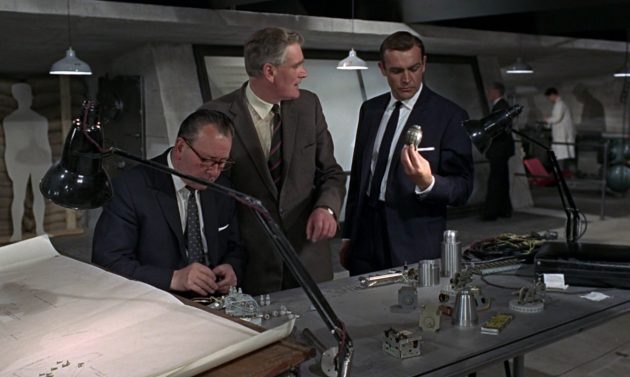

Some of the devices and projects described below have been used in practice, some have remained persistently bold and strange projects. The selection will have some preference for American devices, as many were partially declassified by the Freedom of Information Act in the early 2000s and are now available to the general public.
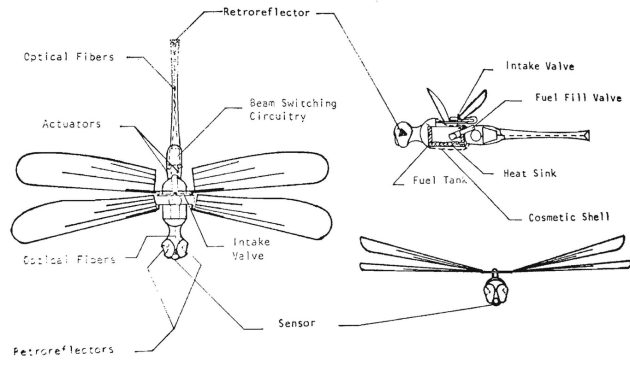
It almost worked. Initially, they wanted to make the device in the form of a bee or bumblebee, but they could not cope with their complex aerodynamics. With archaeopteryxes, which have much simpler flight dynamics, the head of the project, Charles Adkins, did better. The device, which had the appearance of a dragonfly of the species Anax junius or Coryphaeschna adnexa, could fly 200 meters on its own. His task was to deliver to the listening point 0.2 grams of retroreflective balls – the eyes of the dragonfly, which served for the further work of the listening group with the laser acoustic reconnaissance system.
However, making the insectopter fly was not an easy task. Her solution turned out to be the use of a tiny hydrodynamic oscillator that runs on lithium nitrate, a gas released by the crystals. When tests showed that the prototype could not carry the required payload of 0.2 g, the designers added additional thrust by diverting the exhaust gases backwards: similar to a jet engine.
By chance, it turned out that in the first half of the 70s it was impossible to insert at least an elementary control system into this thing – but this problem was also solved. A special laser aimed at the robostrekosis was supposed to heat the metal strip and “turn on” the thrust. The second laser worked on a similar principle as a steering wheel.
The flight of an eavesdropping dragonfly from the declassified archive of the CIA (the cover mistakenly indicates a non-existent microphone in the tail) About 140 thousand dollars were spent on the program (about 2 million at the current exchange rate), it was reported in 1974 about its successful completion … only put into practice the dragonfly of a spy. it turned out to be impossible. Even a light wind outside the ideal conditions of a laboratory or official reception on a carefully selected day led to uncontrollable flight of the device. For which the sample finally ended up in a museum, and in the research and development department of the CIA there was a joke about “a bug with a built-in bug”.
CIA engineers tried to use it in espionage and much larger creatures. Think of the crazy story about the abuse of cats at the CIA (which we strongly condemn). In the early 2000s, another scandal broke out in the American press. Among other things, an old CIA project called “Acoustic Kitty” was then declassified, which horrified animal rights activists and the like. Former Special Assistant to CIA Deputy Director Victor Leo Marchetti Jr. commented on the Telegraph story, calling it “appalling and appalling”.
In 1962, the Caribbean crisis erupted, which almost turned into a global nuclear war. The American political and intelligence leadership was once again overwhelmed by the realization of how little they knew about Moscow’s plans and actions – they learned about the presence of missiles with nuclear warheads in Cuba only from air reconnaissance data, when the complexes were already being deployed on the island. And the very presence of the Soviet troops was discovered by the Americans not thanks to the moles of the CIA, but because they began to build football fields on the island – while the Cubans preferred baseball. In general, the early CIA was greatly overestimated, and the frightening conspiracy theorist Allen Dulles is quite worthy of the Order of Lenin for undermining the efficiency of American intelligence – but that is also a separate story.

In general, Langley was once again buried by the superiors for spending a wild amount of dollars, it is not clear for what, while the Soviets are dragging nuclear missiles right from Florida as if they were at home near Anadyr — and urgently started a stormy activity. Even the craziest ideas were put to the test — and one of them was equipping a cat with listening devices to infiltrate Soviet embassies and other facilities.
But the cat, as you know, walks by itself, and training is weak. To fix it, they resorted to surgery. According to Marchetti, veterinarians implanted a microphone in the cat’s ear canal, implanted a 3/4-inch long transmitter and special batteries under the skin of the chest, and a wire antenna hidden in the fur along the spine to the tail to receive and transmit signals.

However, even the jobs that emerged after the operation were not eager to go where the CIA needed them. Cats are constantly distracted by anything they need to be distracted from. In order to get rid of this, they resorted to an even tougher method of cyborgization and tried to surgically disable part of the “extra” impulses. For example, there is a desire. Kotokiborg must be controlled by special sonar signals that make it go straight, stop or turn left and right.

All this took five years of work, or ten or twenty million dollars. Finally, in 1967, they went to the first experiment “in the field”: the cat had to reach a bench near the Soviet embassy and listen to the conversation of two people. When the unfortunate animal was released from the CIA van, it was frightened by the sounds of the city, rushed across the road and was immediately hit by a car. Epic fail. RIP Kotofeu Well, Marchetti and his colleagues in the van put down a ton of bricks, presenting how they will now go to report to their superiors about the “brilliant results of the experiment.”
Of course, when all this was published in the early 2000s, a wild scandal broke out. The former director of the Technical Service Office, Robert Wallace, was forced to announce to the press that the poor cat had not died at all, that all unforeseen conditions had been removed from him and he lived happily ever after – but, of course, no one believed him.
Well, in Langley, they scratched their heads, counted the costs, cried and switched to a project with spy pigeons. However, luckily for the birds, nothing was injected. In general, the CIA didn’t do anything about mice. Does anyone know though?

… well, not only in the CIA.
A sad French cartoon about the Acoustic Kitty project based on real events (well, almost)
In the beginning, the MGB/KGB bet more on professional work with people than on technical equipment – thanks to which they reached impressive heights. Suffice it to say that one of the reasons that led to the start of the Cold War in the late 1940s was the dissection of part of the massive Soviet intelligence network in the United States that penetrated the highest levels and secrets of the Manhattan Project. This caused a natural panic in American society, intense espionage and McCarthyism: repressive measures against those suspected of sympathizing with leftist and Soviet ideologies.

For a very long time, the Americans did not manage to achieve anything even remotely comparable – or this information is still classified. It happened to the British, despite all their traditions – it is enough to mention the “Cambridge Five”, which collected data for Moscow from the high offices of the British special services. But Soviet intelligence, naturally, even at the beginning of the Cold War, was no stranger to impressive technical solutions. One of the most impressive was the eavesdropping device, which received the English name The Thing in the history of intelligence: simply “Stuka”. Or The Great Seal Bug: “Bug in the Big Press”.

On August 4, 1945, in honor of Camp Artek’s 20th anniversary, the Pioneers presented US Ambassador Averell Harriman with a hand-engraved copy of the Great Seal of the United States as a sign of friendship with their ally, the United States. World War II, still in its early years. nuclear bomb and the Soviets would attack the Japanese in Manchuria). Harriman hung the print in the library of Spaso House, the residence of the American ambassadors in Moscow. Then the alliance ended, the Cold War began, but the innovative gift left no doubt: there were no compact batteries, no wires coming out of the badge, and there were even bugs, people who America believes may not last long. They were very wrong.
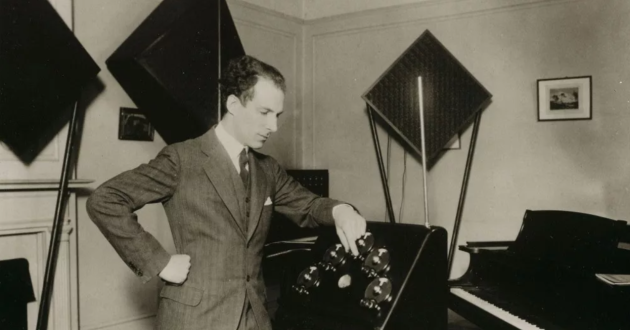
It all started in 1938, when the talented Soviet engineer Lev Serhiyevich Termen was recalled to the USSR from the USA – the creator of the musical instrument Termenvox and early signaling systems. Unfortunately, he was recalled for a reason, accused of espionage for Uruguay, an attempt to blow up the long-deceased Kirov with a radioactive gas in the statue of Foucault – and he ended up in the gold mines of the Gulag. From where he very soon moved to the “Tupoliv marshalling house”, where he had time to work on UAV prototypes with Serhiy Korolyov.
It was there that Lev Termen invented a device he called an endovibrator and ironically nicknamed “Goldilocks”. Thermen’s passive endovibrator worked on the principle of modulation of the reflected radio signal. It consisted of radiation from an antenna with a resonant system tuned to the frequency of the irradiating signal, a receiver of acoustic vibrations and a modulator. The device did not require any independent power supply — but it was powered by decimeter waves at a frequency of 330 MHz, for which buildings adjacent to the embassy or specially equipped trucks were used.
The device worked unnoticed from 1945 to 1952 – and it could not be found for a long time, even when the Americans realized that the embassy was “listening”. They realized this for a good reason, so to speak: listening to secret Soviet signals in Moscow and several times coming across the broadcast of confidential conversations of American and British representatives. How exactly the coat of arms was found is not entirely clear, opinions differ, but it was not easy precisely because of the obvious lack of electricity. After that, the Americans puzzled over how it all works for more than one month.

The discovered bug was not made public until 1960, when Powers’ U-2 high-altitude reconnaissance plane was shot down over the Soviet Union during a CIA mission, and “answers” were urgently needed. The Union also spied on the Americans. At that time, the Americans still understood how an ecological car works, with the help of the British Peter Wright – and with the help of the Dutch, they returned the 1958 “alaverdas” and established a similar error in the Soviet embassy in The Hague. (found six months later). It is interesting that the employees of the American embassies in different countries were afraid for decades that the Soviet Union would irradiate their buildings with decimeter waves and that their health would deteriorate.
Well, Lev Termen himself was rehabilitated in 1947, and in the same year he received the Stalin Prize — continuing to enthusiastically work on new listening systems for the KGB. And towards the end of his life, he still managed to visit Stanford University. By the way, the same Termen worked on the Soviet analogue of the American eavesdropping laser, the Buran infrared system.
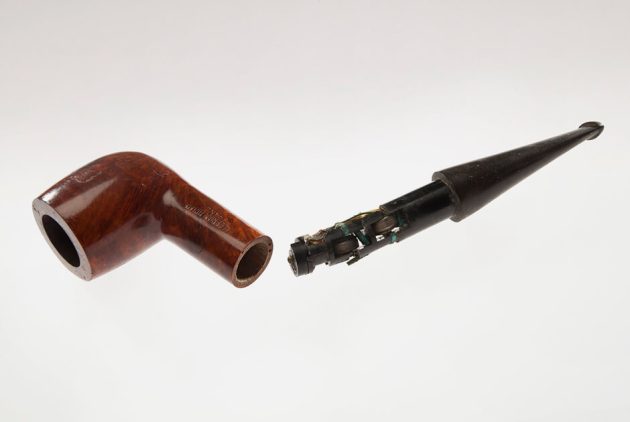
Object 004-RRC (almost SCP) from the CIA museum looks like an ordinary smoking pipe when assembled. These were popular both in the first two thirds of the 20th century and among the hipsters of the 2010s. When, how and under what circumstances this tube was used – or remained a curious project altogether – is not reported.
A device was intended for the agent to receive radio encryption, most likely Morse code (but this is not certain). To work with the radio tube, it should be tightly clamped with the teeth – and the signal should reach the inner ear directly through the teeth and bones of the skull. This is roughly how modern hearing aids and microphones work, which use the phenomenon of bone conduction of sound.

One problem: smoking such a pipe was highly discouraged in order to avoid damage to the equipment. And, most likely, the smoke just couldn’t get through, that’s all. Which somewhat reduced the masking advantages of the gadget: a person sitting thoughtfully with a clearly not smoking pipe in his teeth could look suspicious.
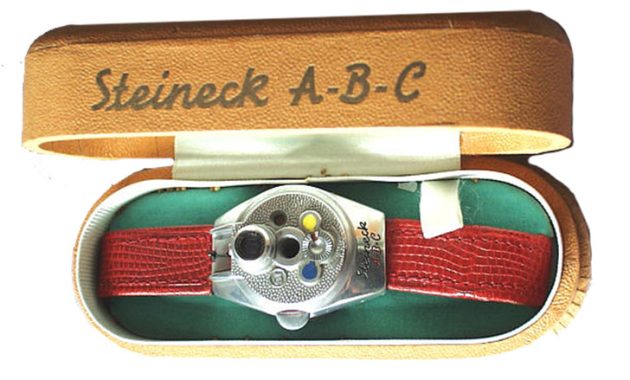
The device came with a Steinheil 12.5mf/2.5 lens with a fixed focal length, and had two aperture modes for bright and dim lighting. Shooting was carried out on a drum of eight photodiscs cut from standard 35 mm photographic film, and was carried out by pressing the thumb with the participation of the index finger.
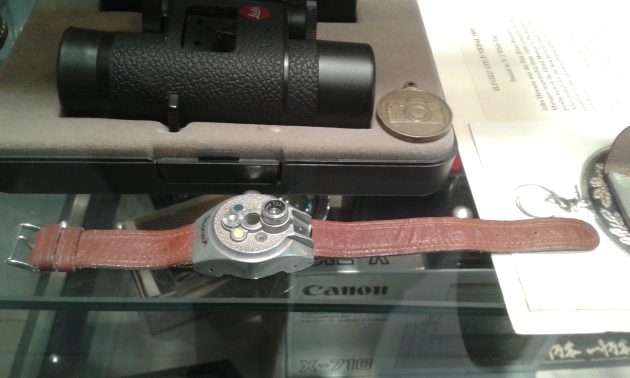
It was probably not recommended to use this device for espionage. These “watches” look too fawn up close: without a dial, but with a lens that clearly sticks out. And they were not suitable for filming documents either: the image was clear no closer than two meters from the person filming. But the device was very popular among “outdoor advertising”, counter-intelligence, investigators and private detectives: with its help, you could take someone from a certain distance to confirm, say, a meeting, without shining a real camera nearby.
That’s all for now – and in the next parts we will talk about unspeakably disgusting containers for secret materials, dangerous umbrella injections and other strange spy devices of the last century. Stay with us!
